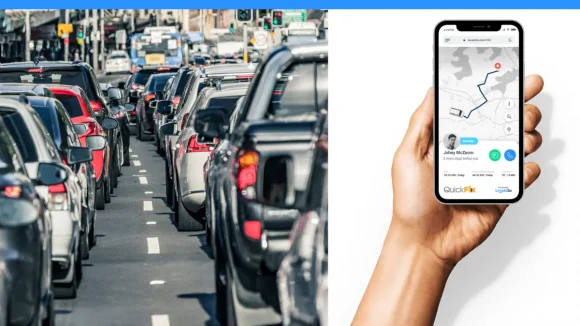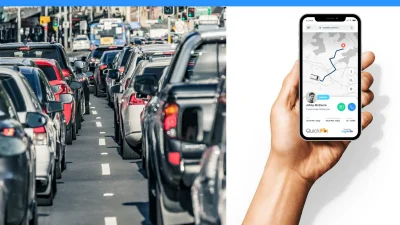In the realm of transportation and logistics, route planning and route optimization are vital components of the delivery process. Businesses rely on route planner software to optimize routes, plan multiple routes, and efficiently navigate the complexities of planning routes. By optimizing routes and planning routes effectively, businesses can streamline their operations, maximize resource utilization, and enhance the overall delivery process. In this article, we will delve into ‘route planning vs route optimization’ and emphasize the benefits of using route planner software to optimize routes and efficiently plan multiple routes. Whether you manage a fleet or oversee delivery operations, mastering the art of optimizing and planning routes can significantly improve your business’s performance and ensure efficient and successful deliveries.
Route Planning Vs Route Optimization
Route planning vs route optimization. Which one do you think is better, we think the answer is pretty obvious.
What is route planning?
The process of choosing the best path or route to take between a starting point and a destination is known as route planning. It entails taking into account a number of variables, including time, distance, traffic, weather, and consumer preferences. Creating a route that is efficient and effective in terms of expenses, travel time, and potential impediments while utilizing resources to the fullest is the aim of route design.
To ensure efficient movement from one site to another, it is frequently utilized in the transportation, logistics, distribution, and field service management industries. It is often used in the transportation, logistics, distribution, and field service management industries to assure effective movement from one site to another.

What is route optimization?
By carefully planning the sequencing and arrangement of numerous stops or places along a route, route optimization is a cutting-edge tactic for increasing transportation efficiency. It goes beyond conventional route planning, which is concerned with choosing the most direct route from A to B. Additional factors including truck capacity, load balance, time windows, delivery priority, fuel efficiency, and emissions reduction are taken into account during route optimization.
Route planning vs Route Optimization: What is the difference between route planning and scheduling?
Route planning and scheduling are two distinct but connected tasks in the realm of logistics and transportation that help with efficient route management. Route planning is concerned with choosing the fastest route between a starting point and a destination while taking into account variables like time, distance, traffic, and client preferences.
In order to reduce travel time, distance, and potential impediments, the best route must be found. Scheduling, on the other hand, entails arranging the tasks or stops along the chosen path in the right sequence and at suitable times. It considers things like delivery deadlines, priorities, resource availability, and client demands. The output of route planning is the selection of the ideal route while scheduling results in a comprehensive plan outlining the sequence and timing of stops or activities along the route.
What is the purpose of route optimization?
The goal of route optimization is to increase transportation effectiveness by identifying the fastest, cheapest way to get from one place to another or accomplish a set of tasks. The goal of route optimization is to reduce travel time, costs, and distance while improving operational efficiency and resource use. By taking into account extra elements like vehicle capacity, load balance, time windows, delivery priority, fuel efficiency, and emissions reduction, it goes above and beyond simple route planning.
Route optimization offers a number of important advantages by enhancing the sequence and order of stops along a route:
Cost Savings
By lowering fuel consumption, vehicle wear and tear, and labor costs, optimized routes can result in significant cost savings. Keeping travel time and distance to a minimum helps to maximize resource use and cut
Enhanced Operational Efficiency: By making the most use of the resources at hand, route optimization improves operational efficiency. It makes sure that routes are established to save pointless detours and idle time, enabling businesses to do more stops or tasks in less time.
Enhanced client Satisfaction
Route optimization leads to better on-time performance, prompt delivery, and shorter client wait times. Increased client satisfaction and loyalty result from this, which is essential for firms in cutthroat markets.
Reduced Environmental Impact: By reducing fuel use and emissions, route optimization promotes environmental sustainability. Organizations can lessen their carbon footprint and encourage environmentally friendly behaviors by optimizing their routes.
Resource Optimization
To ensure effective resource allocation, route optimization takes into account variables including vehicle capacity, load balancing, and time windows. Maximizing the use of the resources already at their disposal, enables businesses to operate with fewer cars or resources overall.
Real-time Adaptability: In some circumstances, route optimization can be carried out in real-time, enabling alterations to routes in response to dynamic situations like traffic congestion, weather, or unforeseen events. Routes are guaranteed to remain optimum even in changeable surroundings thanks to this adaptability.

How do you optimize a route plan?
Finding the most effective sequence and order of stops along a route includes employing a variety of strategies and algorithms. The general procedures for improving a route plan are as follows:
Specify Your Optimization Goals
Decide what precise goals you wish to accomplish through route optimization. These goals may include limiting travel distance, cutting down on travel time, maximizing resource use, staying within time limits, or taking into account other restrictions and considerations particular to your organization or industry.
Obtain Useful Information
Gather and arrange all the information required for route optimization. This comprises details about the stops’ locations, their addresses or coordinates, any applicable time periods, delivery priority, vehicle capacity, traffic restrictions, and any other relevant limitations or variables.
Selecting an optimization algorithm
Choose an optimization algorithm or technique that best meets your unique needs. Numerous algorithms are accessible, including simulated annealing, genetic algorithms, and heuristic algorithms. Each algorithm uses a different method for analyzing and optimizing
Input Data and Constraints
Input the selected optimization procedure with the gathered data and constraints. The start and end points of the route, the locations of the stops, each stop’s specific features and restrictions, and any other pertinent information are all specified here.
Execute the Optimization Algorithm
The optimization algorithm should be run to examine and compare various stop combinations and sequences. In order to discover the best solution that satisfies the given criteria and limitations, the algorithm will iteratively analyze the data and make adjustments.
Analyze and improve the findings
Analyze the outcomes that the optimization method produced. Based on the goals and restrictions you’ve established, evaluate the route plan that was optimized. Rerun the optimization procedure after making any necessary changes to the plan’s restrictions or parameters.
Validate and Implement the Optimized Route
As soon as you are happy with the optimized route plan, validate it by taking into account dynamic aspects like traffic patterns, road closures, and other real-world factors. Implement the route plan that has been optimized into your operations, making sure to take all relevant modifications and concerns into account.
Monitor and adjust
Keep a close eye on how the optimized route plan is doing and adjust it as necessary. The route plan may need to be modified over time due to variables like shifting consumer needs, deteriorating road conditions, or resource availability.
How does a route planning program operate?
To develop the most effective routes, route planning software makes use of cutting-edge algorithms, mapping information, and real-time information. Starting points, destinations, stops, time periods, and constraints are only a few of the data that are input. Based on variables including distance, time, traffic conditions, and delivery priority, the software analyzes the data and generates efficient routes. Alternative paths can be investigated and the options are shown on interactive maps. The software can be integrated with other systems for execution and tracking and produces output in the form of optimized routes.

What are the benefits of route planning?
For companies and organizations engaged in logistics and transportation, route planning software has many advantages. Here are a few significant benefits:
Enhanced Efficiency
Route planning software optimizes travel routes, resulting in less time, fuel, and distance traveled. It enhances operational efficiency overall by maximizing resource use and enabling the completion of more stops or activities in less time.
Cost savings
Route planning software aids in lowering operational expenses by reducing travel time and fuel usage. Additionally, it helps with effective resource allocation by removing pointless detours and idle time, which saves money on labor, fuel, and vehicle maintenance.
Improved client Service: Route optimization guarantees on-time deliveries and shorter client wait times. This results in better customer satisfaction, more loyal customers, and a positive brand reputation.
Real-time Adaptability
Real-time data, such as traffic or weather updates, are incorporated by some route planning software, enabling dynamic changes to routes. This versatility aids in getting past obstacles, traffic, or unplanned situations to ensure dependable and fast delivery.
Enhanced Decision-Making
Enhanced Decision-Making and planning Software for route planning offers information on numerous route possibilities and scenarios. Businesses can use it to assess alternate paths, perform “what-if” analysis, and come to wise conclusions based on reliable information and analysis.
Regulation Constraints
Regulation Constraints, such as Road Restrictions or Time Windows, can be incorporated into route planning software to ensure compliance with legal requirements. It assists in avoiding infractions, fines, and expensive errors.
Collaboration and Integration
GPS tracking devices or fleet management systems can be integrated with route planning software. Due to the seamless execution and tracking of routes made possible by this integration, teamwork and coordination have improved.
Growth and Scalability
Businesses can scale operations effectively by handling huge amounts of stops with route planning software. By accommodating greater demand and streamlining routes for an expanding consumer base, it promotes growth and expansion.

Can Google Maps be used to plan routes?
Yes, you can plan your journey using Google Maps. It offers simple route planning features that let users choose the most direct route between two points. Google Maps will compute the route based on distance, travel time, and other factors once users enter their starting location and destination.
Additionally, Google Maps has capabilities that can help with route planning. To aid users in efficiently navigating, it offers turn-by-turn directions, options for alternate routes, and real-time traffic information. By choosing choices like avoiding tolls or roads, users can tailor their preferred route.
Although Google Maps has the ability to create routes, it might not give the same level of optimization and customization as specialized route planning software or applications. Complex logistical requirements for businesses and organizations may necessitate the use of more sophisticated route planning tools that can handle numerous stops, time windows, concerns for vehicle capacity, and other specialized features.

What are the key elements of route planning?
The following are the main factors in route planning:
- Start and Destination Points: Determining the journey’s starting and ending points is the first step in route planning. These locations act as the anchors for choosing the best course.
- Stops and Waypoints: When planning a route, several stops and waypoints must be taken into account. These could be stops along the route for customer visits, service calls, or delivery destinations.
- Knowing the distance and travel time: Knowing the distance and travel time between each place is crucial when determining a route. This enables weighing the benefits and drawbacks of many route options and selecting the best one easier.
- Traffic: It’s important to consider both past and present traffic data while deciding on a route. Traffic conditions affect travel times, thus selecting routes with the fewest delays requires taking traffic congestion or road closures into consideration.
- Road limits and limitations: It is crucial to consider any potential road restrictions or limitations while designing a route. A few of these are particular access requirements, one-way streets, weight and height restrictions, and road closures.
- Time Windows: Route planning takes into account any time restrictions or designated time windows for deliveries or appointments. To satisfy these demands, the planner or program optimizes the order and timing of pauses.
- Delivery Priorities: Prioritizing stops according to service level agreements or client requirements is a crucial part of route planning. It guarantees that stops with higher priorities are properly planned and given priority in the route plan.
- Vehicle Capacity and Load Balancing: Route design optimizes the load distribution while taking into account the capacity of the vehicles being employed. By doing so, resources are used to their fullest potential, and the overloading or underloading of vehicles is prevented.
- Algorithms for Optimization: Using optimization algorithms or techniques is an essential part of route planning. These algorithms compute the most effective and optimum routes by analyzing a variety of variables, including distance, time, traffic, delivery priorities, and constraints.

What is route planning software?
A computer program or application known as “route planning software” was created expressly to support the management and optimization of routes for the needs of transportation and logistics. The most effective routes are generated based on specified objectives and restrictions after analyzing numerous elements using cutting-edge technology and algorithms. Software used to plan routes takes into account factors including distance, time, traffic, road conditions, priority of deliveries, truck capacity, and customer requirements.
Route planning software is used by companies and organizations in delivery services, field service management, fleet management, and other industries that require efficient route optimization. Operations are more efficiently run, resources are better utilized, costs are reduced, customer service is enhanced, and data-driven decisions are made feasible.
Route planning vs Route optimization: What’s the difference?
Route planning vs Route optimization…What’s the difference?
Using human judgment and the information at hand, manual route planning entails the manual selection and organizing of routes. Due to the processing capacity being constrained, it can be time-consuming and lead to less-than-ideal routes. Route optimization, on the other hand, makes use of algorithms and software to automatically examine different parameters and produce highly efficient routes. It maximizes resource usage and reduces costs since it is effective, flexible, and takes several factors into account at once.
Route optimization software for your business: Locate2u
Looking to optimize your delivery routes and streamline your delivery operations? Try Locate2u, the ultimate route planning software, and delivery route planning tool. Say goodbye to manual route planning and let Locate2u optimize your routes for efficient delivery processes.
With Locate2u’s advanced routing software, you can effortlessly plan and optimize delivery routes, ensuring your delivery drivers take the most efficient paths to reach their destinations. Maximize resource utilization, reduce costs, and improve customer satisfaction with Locate2u’s powerful route planning capabilities.
Don’t settle for complicated and time-consuming route planning methods. Optimize your delivery routes with Locate2u and experience the ease and efficiency of automated route planning. Start optimizing your delivery routes today and watch your delivery operations soar to new heights.
Click here and start optimizing your delivery routes with Locate2u today!
About the author
Marketing Coordinator at Locate2u having completed a Bachelor of Creative Arts, majoring in English Literature and Creative Writing. I have extensive experience in editing and proofreading, as well as creating content for a range of audiences.











